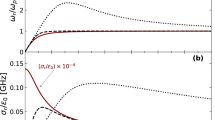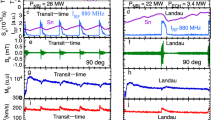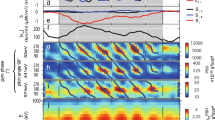Abstract
WHEN an object moves rapidly in an ionized gas, its surface, if electrically conducting, will become charged due to the differential in mobilities of the electrons and ions in the gas. Assuming that the medium is in thermodynamic equilibrium and consists of singly charged particles only, the surface will acquire a negative potential. The equilibrium surface potential will be reached when the incident fluxes of electrons and ions become equalized by the biased surface potential. A charged body influences, by electrostatic interaction, the trajectories and concentrations of the neighbouring charged particles which, in turn, modify the potential field by their presence as space charges. This electrodynamic phenomenon, which occurs in the immediate vicinity of a body moving rapidly in a rarefied ionized medium, is the plasma interaction of interest. A variety of scientific experiments have led to the discussion of this problem. As an example we may cite the measurement of the upper ionosphere by the use of a satellite probing scheme. The ionospheric quantities of interest, for example, electron density and temperature, must be inferred from the planned measurements made at the satellite body which is, of course, shielded by a cloud of charged particles and their associated potential field. The theory of measurement, therefore, must be based on an understanding of the specific plasma interaction developed.
This is a preview of subscription content, access via your institution
Access options
Subscribe to this journal
Receive 51 print issues and online access
$199.00 per year
only $3.90 per issue
Buy this article
- Purchase on Springer Link
- Instant access to full article PDF
Prices may be subject to local taxes which are calculated during checkout
Similar content being viewed by others
References
Al'pert, V. A. L., Gurevich, A. V., and Pitaevskii, L. P., Soviet Phys. Uspekhi, 6, 13 (1963).
Schiff, L. I., Quantum Mechanics (McGraw-Hill, 1955).
Hays, P. B., Ph. D. thesis, Univ. of Mich. 1964 (available from Univ. Microfilm Co., Ann Arbor).
Ginzburg, M. A., Trudy Izmiran, Akademii Nauk S.S.S.R. No. 17 (1960) (Engl. Trans. A.R.S.J., 32, 1794, 1962).
Kamke, E., Differential Gleichungen Lösungsmthoden and Losungen, Bd. I, Chelsea, 1948.
Bohm, D., and Vigier, J. P., Phys. Rev., 96, 208 (1954).
Liu, V. C., Pang, S. C., and Jew, H., Phys. Fluids, 8, 788 (1965).
Author information
Authors and Affiliations
Rights and permissions
About this article
Cite this article
LIU, V. A Wave Mechanical Approach to the Plasma Interaction Problems. Nature 208, 883–884 (1965). https://doi.org/10.1038/208883a0
Issue Date:
DOI: https://doi.org/10.1038/208883a0
This article is cited by
-
Ionospheric gas dynamics of satellites and diagnostic probes
Space Science Reviews (1969)
-
Particles trapped in the Potential Well behind a Mesothermally Moving Satellite
Nature (1967)
Comments
By submitting a comment you agree to abide by our Terms and Community Guidelines. If you find something abusive or that does not comply with our terms or guidelines please flag it as inappropriate.



